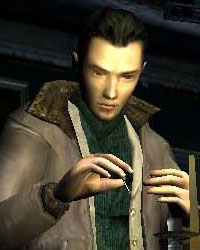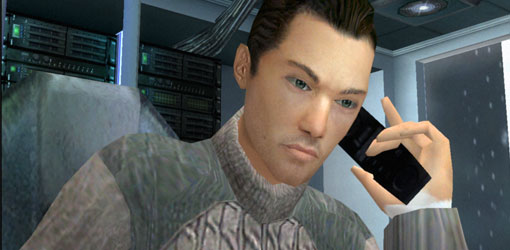INDIGO PROPHECY: Developer's Diary

THE CONCEPT
Some Thoughts About Games
After the development of my previous game Omikron, I started asking why there aren't more people playing videogames. I can appreciate the same books, TV shows and movies as, let's say, my parents, but they definitely could not have the same appreciation that I have for videogames. Why is this?
I asked people of different ages, tastes, and backgrounds why they don't play video games to try and get to the bottom of this. The answers were always the same: "Videogames? They are for kids," I was told. "They are too complicated," some admitted. "I don't have time for that," or "I don't understand anything". The truth for many people is that they just aren't interested.
At the same time, I stumbled upon another group of people too: the "ex" gamers. These were people who played videogames when they were kids, but quit at some point to do more serious stuff. These people told me things like "I don't have time to play anymore," which I interpreted as "I'm not interested anymore."
All of these people could understand the entertainment value of literature, TV or cinema, but not the value of games.
These simple thoughts initiated the process that led me to design Indigo Prophecy. I tried to take one or two steps back to see video games through their eyes. As a pure geek and videogame addict since the Oric 1 home computer, it's been an interesting exercise.
 I started to truly open my eyes at a conference I was participating in with a keynote speaker from a major publisher. The man brilliantly summarized his vision of videogames with his first sentence: "What do
I started to truly open my eyes at a conference I was participating in with a keynote speaker from a major publisher. The man brilliantly summarized his vision of videogames with his first sentence: "What dogamers really want to do in games? They want to destroy. We decided to give them what they want".
Was this really the publishers' vision of interactivity? Is "Destroy" the key word defining players' expectations? Are they really a herd of teenagers whispering, "REDRUM" like in Kubrick's movie "The Shining"?
If that was really the case, I probably had to reconsider what I wanted to do in life. At the same time, it would explain why so many people were not interested at all in videogames: most of them would have more expectations from a form of entertainment than just to shoot at zombies or destroy cars.
So I started to search in my gamer's memory for all the games I have played, trying to figure out if the word "Destroy" could define them all. The answer was "No" or to be more accurate, it was "No, but almost".
In fact, I realized that most games were based on the same five basic emotions: excitement, competition, fear, frustration, and pride.
In short, excitement is about the pleasure of displaying power by killing or destroying (like in any shooter game), competition is about showing that we are better than the others (like in sports games or any game with competitors), frustration is about failing and starting again, and pride is about getting unique items and customizing one's character.
These primitive emotions are based on two neurotransmitters, adrenaline and dopamine. Both are known for their physical effects on the body and in the case of dopamine, for its addicting power.
"Five emotions to rule them all," five primitive feelings to describe all games.
I would be lying if I said that I did not understand why some people could have no interest in videogames. I felt something similar myself to a certain extent. For a while, I had the feeling that games were just repeating themselves over and over, year after year, just with better graphics.
At the same time, I felt less and less interest in games' characters, worlds and topics, I felt bored seeing always the same stereotypes, poor storytelling and acting, gratuitous violence and total lack of any real meaning. I realized that most games were designed for an audience of kids between 10 and 14 years old. At 36, like many other gamers, I was definitely not a part of this target anymore.
Did it mean that I had to quit games like other players before me? Are video games just toys for kids and have absolutely no potential to become anything else?
This is how I decided to design Indigo Prophecy. I wanted to create a game that anyone could easily enjoy, that would not be based on the mastering of controls but on involvement. It would not rely on violence but on emotions, would not reduce interactivity to destruction but would try to show that it is possible to interact with something or someone without a gun. Last but not least, I wanted to create an experience for adults with mature, realistic, believable topics, not for 10-year-old kids. In short, I wanted to see if games had a chance to become more than toys one day.
I had absolutely no idea of the difficulty of this challenge, as I quickly realized that something was missing to create this experience: a language.

Interactive Storytelling, or the Holy Grail
Storytelling is one of the most ancient human activities. Every time mankind has invented a new form of media, it has used it to tell stories: spoken language, drawing, writing, theatre, cinema, and television. Why should videogames be the only exception?
Storytelling in videogames is usually very simple. We use stories in basically the same way as porn movies: a bit of story to set up the context and introduce the characters, then the big action scene. Another bit of story to set up the context for the next scene, then another big action scene. No one cares for the quality of the story, because no one is really there for that. The story is just a minor device wrapping action scenes.
My ambition with Indigo Prophecy was to create a game where storytelling would be at the center of the experience rather than a peripheral element. I strongly felt that it would allow me to extend the range of emotions that the game could offer. In my mind, a good story with interesting characters could convince anyone to want to play. Everybody wants to know what will happen next as long as they feel empathy for the characters. I thought I could transfer the challenge from "master the controller" to "make the right choices in the story and see how your decisions change the plot."
In most games, the story only progresses by means of cut scenes, as the action sequences generally carry no meaning. The main difficulty I knew I would have to face was to make the story progress through player's actions and not through cut scenes. The experience would have to be totally fluid and organic, and the story should progress naturally because of the player.
This main issue can be broken down into two smaller ones: interactive storytelling and interface.
Interactive storytelling is sometimes considered an impossible problem to solve: storytelling is supposed to be linear by essence while interactivity is non linear. The paradigm of interactive storytelling would be to let the player make choices that would have tangible consequences on the story. The simpler way to do that would be to offer choices as often as possible and manage all consequences. But choices would generate choices that would generate more choices, quickly resulting in a huge tree-structure that would be totally impossible to manage. Keeping track of all the choices and all their possible consequences in the story would create exponential possibilities.
On the other side, not having enough choices would result in a very linear story, a kind of Dragon's Lair experience where the player's choices would be limited to choosing A or B.
Last but not least, our experience would have to guarantee the quality and the pacing of the storytelling whatever the player does. No good or bad story depending on player's choices, but always a consistent and "dead-end free" experience. This is how I started working on what I call "Bending Stories". I think of my story as a rubber band; the player can stretch or deform the rubber band through his actions, but whatever he does the backbone of my story is always there. The player can have the feeling of playing with the story, almost in a physical sense by stretching it, but he can never break it. His choices can have very tangible consequences, but within the boundaries of a well-written narrative. Each scene, each action, can be considered like a rubber band itself, and each rubber band can stretch another rubber band later in the narrative, which can in turn impact the overall story. Possibilities are limitless and allow the writer to remain in control of the tale that is told.
This writing technique is similar to the "Choose your own adventure" books in a certain way; except that there are many more choices involved, and each choice can trigger consequences at any point in the story. Possibilities are truly endless.
I don't want to set wrong expectations: Indigo Prophecy and the rubber band story idea is not a proposition to generate dynamic storytelling. All events are scripted and the range of possibilities is pre-established, but this writing technique allows us to open a real narrative space within the story while maintaining its pacing and quality.
Consequences managed with this technique can be very significant for the player: in Indigo Prophecy, scenes can be played several times with different outcomes that may in turn affect other scenes. Two players playing the same scene can see or totally miss different parts of the game although both will experience the same overall story.
NEXT >>
Labels: David Cage, Developers Diaries, English, Fahrenheit Indigo Prophecy
Previous News
- INDIGO PROPHECY: Developer's Diary
- Quantic Dream choose Malaysia
- GamePro.com: Q & A with David Cage About Indigo Pr...
- Fahrenheit Poland
- JeuxVideo: David Cage est ici
- Fahrenheit ( Пророчество цвета Индиго) Russian
- Fahrenheit Australia and NZ
- Fahrenheit (Indigo Prophecy) Swerige
- Fahrenheit (Indigo Prophecy) España
- Fahrenheit (Indigo Prophecy) Portugal


 Thursday, September 22, 2005
Thursday, September 22, 2005